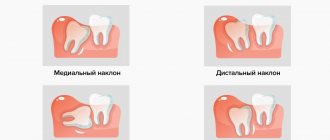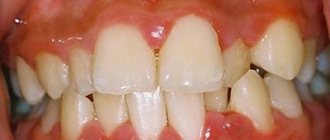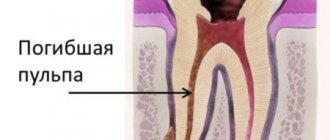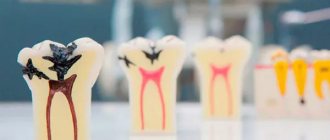What is periodontitis?
We can easily notice changes in the appearance of teeth and the appearance of carious lesions on the enamel at home, limiting ourselves to one visual examination of the oral cavity. But things are completely different when you need to know the condition of the pulp. The pulp is the heart of the tooth, which is hidden from prying eyes. To see it, you need to undergo an x-ray examination by a dentist. The same applies to the root and basal tissue of the tooth; their diagnosis is carried out only using an x-ray. Inflammation of the periodontal tissues can be fraught with dangerous consequences; if the infection penetrates deep into the tooth and goes beyond the root canals, a person may lose the tooth.
Possible problems
Treating toothache under a crown is often fraught with problems. Among them:
- The crown is installed on a pin, which must be removed during treatment. This may lead to perforation of the root, which can lead to its fracture and subsequent root removal;
- the canals are filled only after the previous filling has been completely removed, which often causes root perforation;
- After cleaning the old filling, it is necessary to undergo a course of treatment with anti-inflammatory drugs and only then can a new crown be installed.
Reasons for the development of periodontitis.
When caries begins, pathogenic bacteria begin to actively multiply and if the disease is not cured in a timely manner, the inflammatory process spreads to the enamel and affects the dentin. When the infection reaches the pulp, a complication of caries develops. It is untreated pulpitis that causes periodontitis. Once in the periodontium, the infection begins to irritate it, causing its response. This is how our body reacts to problems: the patient may experience increasing pain, which is localized and sometimes becomes completely unbearable.
It should also be noted that the formation of periodontitis is also possible under other conditions:
Poorly sealed canals.
When filling, it is important to fill the root canals tightly and correctly with the material, and for this it is necessary to determine their size using radiography. If the dentist skipped this stage and did not fill the canal, inflammation may begin in the remaining space.
Mechanical injury to the jaw or teeth.
Very often, periodontitis occurs in children, because... Little fidgets constantly fall, and sometimes they can hurt their faces, you should pay attention if your child, after such an active walk, begins to complain of severe tooth pain.
Development of infection under the crown.
In this case, periodontitis occurs due to the incompetence of the doctor, or he incorrectly carried out the preparation stage and poorly processed the tooth and filled it, or an error was made when placing the crown, and the dentist did not remove the dead pulp.
Use of arsenic.
Previously, arsenic was used to kill the pulp, if the dose is incorrectly determined and with its long-term effect on the body, there is a high risk of an inflammatory process in the periodontal area. Currently, dentists use high-quality anesthetics that allow them to treat and remove the pulp without exposure to arsenic paste.
Use of antiseptic drugs.
One of the main reasons for the development of drug-induced periodontitis is the excess concentration of drugs during filling and treatment of root canals.
When a tooth hurts under the crown...
It is generally accepted that to treat a tooth, it is necessary to remove the crown. But high-quality dentures are not cheap, and they are not suitable for reuse. Therefore, it is doubly unpleasant when pain appears several months after prosthetics, and it becomes necessary to remove a crown that has not served its purpose.
In this case, patients often put off a visit to the dentist with all their might. For example, they take painkillers and antibiotics or experiment with very dubious “folk” methods. But by self-medicating, you will not solve, but will only aggravate the problem, since advanced inflammation is much more difficult to treat. If discomfort or pain occurs, you should immediately visit your dentist. Moreover, contrary to popular belief, modern treatment methods, in some cases, make it possible to do without removing the crown.
In some cases, treatment is possible without removing the crown.
Symptoms and signs of periodontitis.
As mentioned earlier, periodontitis may not manifest itself for a long time; the patient runs the risk of finding out about the disease too late, when it has entered the acute stage. In this case, the signs of inflammation of periodontal tissues will be felt much more clearly. Periodontitis is characterized by the following symptoms:
Deterioration of general condition.
There is an increase in temperature, worsening sleep, weakness, etc.
- Pain when chewing food and when closing the jaws.
- Change in gum color (become darker).
Based on this symptom, periodontitis can be identified in its initial stages of development. Also, the periodontal tissues may swell, and the swelling may spread to the cheek and neck.
Painful sensations.
In the acute course of the disease, the patient begins to be bothered by a sharp, aching pain that radiates to neighboring teeth.
- Slight tooth mobility.
- The appearance of bad breath.
- Increased sensitivity due to mechanical impact on the tooth.
Prosthetics with crowns
Installing a crown on a tooth is a procedure to restore its anatomical shape, color, chewing function and aesthetics.
In practice, any tooth under a crown (with or without a preserved nerve) can begin to hurt. In this case, only a specialist can provide assistance. Lack of professional treatment or late contact with a doctor aggravates the situation; removal of the causative tooth may be necessary.
After professionally performed prosthetics, pain should not occur. At first, you may experience some discomfort associated with getting used to the new product in your mouth. If you have a crown installed and your tooth hurts, you should immediately tell your doctor about it.
Types of periodontitis.
There are several classifications of periodontitis; it is usually distinguished by the place of formation: apical (infection affects the base or apex of the root) and marginal (occurs in the area of the gum edge due to injury).
According to the nature of the course of the disease, the following stages are distinguished:
Acute periodontitis.
It is further divided into several forms: serous acute periodontitis is the initial stage of the development of inflammation; it occurs after the infection penetrates through the apex of the tooth root into the periodontal area. Then it develops into purulent acute periodontitis. This form of the disease is very dangerous because The pus penetrates the bone structures and can spread throughout the body. It is characterized by: severe increasing pain, painful sensations when pressing on the tooth and when biting, headache, swelling of the mucous membrane, etc.
Chronic.
It has three stages of development: fibrous, granulating and granulomatous. Chronic periodontitis is characterized by a calm and even imperceptible course of the inflammatory process; only sometimes the patient may experience slight pain when tapping a painful tooth. But at the same time, this stage is considered the most dangerous, because may lead to tooth loss. With the development of the granulating form, the unit and the tissues around it are destroyed. A fistula forms on the gum, from which pus flows. Granulomatous periodontitis is characterized by the formation of a granuloma, a sac filled with purulent fluid, which subsequently develops into a cyst if not removed. Tooth mobility increases, gums bleed, and abscesses develop.
Prevention
To avoid complications during prosthetics and associated pain, the patient should:
- follow all doctor’s recommendations for caring for the oral cavity and dentures;
- Carry out professional cleaning of all dental units twice a year;
- do not try to crack nuts on the prosthetic side;
- carefully choose a clinic for prosthetics; Experienced specialists in most cases manage to avoid complications when installing a variety of types of dentures; patients of the YuliStom clinic do not experience severe pain after prosthetics; The schedule of specialists can be found on our website.
Treatment of periodontitis.
During the examination, the dentist will determine the degree of development of periodontitis, and the treatment plan will depend on this. Making a diagnosis is not difficult; upon visual examination of the oral cavity, one will notice severe destruction of the tooth structure, a change in the color of the gums, and there is no reaction to cold and hot water. Eliminating the consequences of inflammation of periodontal tissue can take quite a long time; you will have to visit the doctor several times. Several years ago, such a diagnosis forced doctors to remove the damaged tooth, but now the patient has the opportunity to maintain the integrity of the dentition and get rid of the inflammatory process.
Treatment of periodontitis is possible in several ways; if therapeutic methods are not effective, the dentist uses surgical intervention. Let's take a closer look at the stages of treatment:
Treatment of a damaged tooth.
First, it is necessary to open access to the root canals, remove softened dentin and remnants of infected tissue. This procedure is performed using a special bur, after which the cleaned cavity is treated with antibacterial drugs. Then the tooth canals are widened, washed with antiseptic solutions and the medicine is placed in them. Until the inflammation is stopped, the doctor has no right to proceed to the next stage.
Filling.
At the end of the treatment, the root canals are tightly filled. In most cases, these actions are enough to get rid of inflammation, the microflora of the tooth is normalized, and its tissues are regenerated.
This treatment option is a conservative method; surgical intervention is performed according to a different plan:
The operation is performed under anesthesia. In the area where the granuloma is located, an incision is made into the mucous membrane and periosteum, resection of the root apex is performed and the purulent neoplasm is cleaned out. The wound is washed with antibacterial drugs, disinfected, and sutures are applied.
If the patient's periodontitis is in the last stages of development and treatment does not have a positive effect, then a decision is made to remove the tooth.
How to treat a tooth with a crown
When the nerve under the crown of a tooth hurts, treatment is carried out differently depending on the clinical situation and X-ray data. Today, treatment is increasingly carried out through a drilled hole in the prosthesis. But sometimes the crown should be removed and only then the necessary treatment should be carried out. Mandatory removal of the structure is required when:
- rapidly developing deep caries, complicated by pulpitis and periodontitis;
- incorrectly installed crown or its destruction;
- allergies to prosthetic material;
- abscess, cyst in the area of the apex of the tooth root.
After treatment, the orthopedic structure is reinstalled. This can be an old crown (if it is completely preserved) or a new one (if the tooth has acquired a different shape after treatment). After treatment, the hole in the crown is sealed with a light-curing filling material.
Removing a crown for tooth treatment
"Living" tooth
This is a unit with no pulp removed. Most often, it performs a supporting function in a bridge prosthesis. If for some reason secondary caries develops in it, the artificial structure is removed under local anesthesia or a hole is drilled in it. The tooth cavity is opened, the pulp is removed, the root canals are cleaned and a complete filling is performed. After this, a crown is installed or the hole made through which the treatment was performed is repaired.
With the nerve removed
A pulpless tooth does not have a nerve (pulp). Pain is associated with problems in the area of the tooth root. To determine the cause of the pain, x-rays are performed. Treatment can take place both with the crown removed and through a drilled hole. The root canals are cleaned, foreign bodies and excess cement are removed. Treat or remove abscesses, cysts, granulomas. Then re-prosthetics or restoration of the integrity of the crown is carried out using photo-curing materials.
Types of complications with fixed dental prosthetics
The most common types of complications encountered with fixed prosthetics are:
Stomatitis and gingivitis (inflammatory processes of the gums)
Stomatitis and gingivitis
This type of complication mainly arises from improper grinding of teeth; this concerns preparation without the so-called ledge on which the lower part of the crown sits and in no case should it hang over the tooth or be pressed into the gum. The second reason may be a very massive intermediate part of the bridge, which puts pressure on the gum. Accompanied by cutting pain, redness and swelling in the pressure area. It would also be incorrect to consider too large or too small a space between the intermediate part and the gum - the rinsing space; this will lead to the accumulation of food debris and bacteria, which will ultimately cause an unpleasant odor and an inflammatory reaction. The presence of sharp edges of bridges and individual crowns can provoke chronic injury - rubbing of the tongue and cheeks . In case of any inflammatory phenomena of the oral mucosa after prosthetics, you should consult a doctor. As anti-inflammatory therapy, you can use various gels, for example Metrogyl Denta, as well as various herbal decoctions and extracts, for example Rotokan.
Dental diseases under dentures (caries, pulpitis, periodontitis)
It is important to understand that all orthopedic structures are fixed either to completely healthy teeth or to teeth prepared in advance for prosthetics. In case of insufficient diagnosis or improper preparation of the oral cavity for prosthetics, complications such as caries under the crowns, pulpitis or even periodontitis may occur. A pathological process that goes undetected in time will ultimately lead to tooth extraction. Periodontitis can also be caused by non-compliance with certain rules when planning the structure, for example, if a bridge is too long in length or a crown that is too high, which will lead to overload of the tissues that hold the tooth in the bone.
Periodontitis (inflammatory processes of all tissues surrounding the tooth)
Periodontitis
The most important cause of periodontitis in fixed prosthetics is the preparation of teeth without a ledge. As a result, the dental technician will not be able to make the correct crown on the model. It will definitely hang over the tooth and cement will remain under the overhanging edge during fixation, which will provoke a pathological reaction and it is not possible to remove this cement from there without damaging the structure. This is manifested by cyanosis of the gums, swelling and bleeding , followed by recession, darkening and exposure of the gray edge of the crown. Naturally, aesthetics are also compromised.
The choice of design depends on many factors, such as the general condition of the body, gum biotype, length of the defect, etc. If all conditions are not taken into account sufficiently, an inflammatory reaction of all tissues surrounding the tooth may occur, which will lead to rapid atrophy of the bone around the affected tooth and, accordingly, its loss. To prevent this complication, an odonto-periodontogram is often performed before prosthetics, which is a graphical recording of the condition of the periodontium and the degree of atrophy of its tissues. Odontoparodontogram during prosthetics helps to choose the correct design of the prosthesis and determine the number of supporting teeth.
Allergic reactions to materials used in prosthetics
Allergic reactions to materials used in prosthetics.
Mainly allergies after orthopedic treatment when an artificial prosthesis comes into contact with the gums and can manifest itself locally in the form of gingivitis with symptoms such as redness and rashes on the oral mucosa, burning and dryness in the mouth, or more general ones. reactions of the body, such as a rash on the skin of the face , swelling, an attack of bronchial asthma. Such reactions can appear either immediately or several hours or even days after installation of the prosthesis. Any allergic reaction during prosthetics requires analysis of the cause and subsequent treatment.
Galvanic syndrome
Such a reaction as galvanism requires special consideration. It manifests itself in the presence of various metals in the oral cavity, and this only happens on exposed metal and does not apply to dentures lined with ceramics. When saliva enters, which acts as an electrolyte, the metals acquire different potentials, resulting in the formation of galvanic currents. Symptoms of this complication are a metallic taste in the mouth, dryness, burning, headaches, sleep disturbances, and local darkening of metal dentures is possible. When galvanism is detected, it is necessary to replace all metal structures with prostheses made of more bioinert materials .
Cementation and loosening of a fixed structure
Dental cements on which permanent structures are fixed must meet certain requirements. However, sometimes de-cementation (“unsticking”) of the permanent structure occurs. This can occur from excessive load, an incorrectly ground tooth, a bridge that is too long, expired or insufficient cement for fixation, as well as one large or several small fillings on a tooth that fly off while remaining in the crown.
Chips of the lining of artificial teeth and crowns
Chips in the lining of artificial teeth and crowns
The lining of crowns and artificial teeth consists of porcelain, this material is beautiful and strong, but if overloaded, it cannot withstand deformation and chips. The cause may be an error in the planning of the orthopedic design, a technical error in manufacturing, as well as the patient's frequent consumption of too hard foods, such as nuts and bones. Sometimes chips can be restored without removing the orthopedic structure, right in the oral cavity, but only the attending physician can resolve this issue.
Malocclusion due to crowns and teeth that are too low or too high
In the case of too low clinical crowns, the efficiency of the chewing function will be quite low, and in the case of too high crowns, the entire masticatory apparatus . Malocclusion sooner or later causes even more serious disorders of the temporomandibular joint, as well as neurological disorders, which can often be expressed in the form of headaches. If the patient feels that he is not grinding food tightly and too large pieces of food remain, or feels pain in the joints after prosthetics, he should immediately consult a doctor to correct the bite.
Violation of the plane during prosthetics
For any prosthetics, the so-called occlusal plane is very important. By it we mean a plane passing through the cutting edges of the central incisors and the distal cusps of the seventh teeth separately for the upper and lower jaws. Incorrect prosthetics can lead to disruption of this plane and disruption of the movements of the temporomandibular joint. This often manifests itself with serious adverse consequences in the form of facial and headaches, pain in the joint area, and clicking when opening the mouth. Such errors require long and careful treatment. In this case, in-depth gnathological studies will be needed, which are carried out in our clinic. Gnathology examines the interaction of all organs of the dental system and affects many factors. Today, much attention is paid to the development of gnathology and neuromuscular dentistry.
Fractures of bridges and crowns
Fractures of bridges and crowns
Fractures, as a rule, can occur in those fixed prostheses that cannot withstand excessive load, as well as due to technical errors: too thin a frame or a very narrowed part. This complication mainly applies to stamped-soldered and temporary plastic structures. Stamped-brazed structures today are practically replaced by prostheses made of stronger materials. And replacing temporary plastic ones, if necessary, is practically easy and does not take much time.











